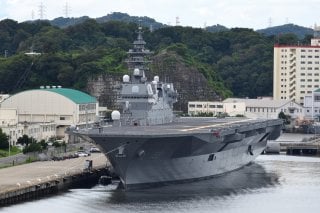Japan’s Izumo-class “Helicopter Destroyer” Can’t Defeat China’s A2/AD
Even when deployed alongside U.S., British, Australian, or other allied naval powers, the Chinese A2/AD threat to surface warships is so profound and complex that whatever technological advantages the Izumo-class has over its Chinese rivals are less important than the advantages that Beijing’s forces have amassed over the last decade in the region.
For all the talk about how the People’s Republic of China (PRC) is rising to dominate the Indo-Pacific not only economically but militarily, many often overlook China’s arch historical nemesis and neighbor, Japan.
Sure, China dwarfs Japan in terms of size and its overall economic output, but Japan is probably among the most advanced nations in the whole world. Indeed, the technology Japan possesses is likely (at least for now) far ahead of the technologies currently available either to Chinese citizens or the Chinese military (again, this is already changing and is likely to continue changing over time).
One area where Japan is lightyears beyond China technically is in its navy. But all the technological advantages of Japan are being utterly wasted by Tokyo on things like its Izumo-class helicopter destroyer.
That’s because the Izumo-class is really a light aircraft carrier. And, if America’s recent experiences against the Iranian-backed Houthis in Yemen haven’t shown, aircraft carriers are to the modern maritime battlefield what the battleships of yore were to the naval battles of World War II.
They’re obsolete, no matter how many whizbang technologies the Japanese incorporate into them.
The Ship
The Izumo-class “helicopter destroyer” is a miniature aircraft carrier. The Japan Maritime Self-Defense Force (JMSDF) possesses two of these ships, the JS Izumo (DDH-183) and JS Kaga (DDH-184). They account for being the largest vessels that Japan has built since the end of World War II. These warships were originally intended for anti-submarine warfare and disaster relief. Tokyo, however, quickly refashioned them into secret aircraft carriers as the Japanese watched China becoming more belligerent at sea.
Indeed, it is feared that China’s objective of conquering Taiwan is not the end goal of Chinese maritime revanchism, but only the start. Once Taiwan is captured by China’s military, the Chinese People’s Liberation Army Navy (PLAN) would have a better chance of successfully blockading China’s major regional rival, Japan. Already, China is outproducing military equipment compared to the Japanese Self-Defense forces.
Ditto even for the militaries of the United States and its other allies.
Japan’s Izumo-class helicopter destroyers displace around 27,000 tons when fully loaded and are comparable in size to light aircraft carriers (that’s actually what they are). The Izumos can accommodate up to twenty-eight helicopters or fourteen larger aircraft. When the boats were primarily used as anti-submarine warfare ships, they had an initial complement of seven SH-60J/K anti-submarine warfare helos and two search-and-rescue helicopters.
On the flight deck, they can accommodate the launch of up to five helicopters simultaneously. Originally, Japan’s war planners had not intended for fixed-wing aircraft to be deployed from these boats.
Yet, the Japanese designers of the Izumo-class helicopter destroyers included aircraft elevators and deck coatings that hinted at potential fixed-wing aircraft operations in the future. And wouldn’t you know it, with Japan’s purchase of Lockheed Martin’s F-35B Lightning II fifth-generation multirole warplanes, which have vertical-takeoff and landing (VTOL) capabilities, the Izumos are now aircraft carriers in all but name.
Indeed, by bringing fifth-generation warplanes into their complement of aircraft onboard, the Izumo-class now punches well above its weight as a “helicopter destroyer” warship.
The Age of the Aircraft Carrier is Over
Here’s the problem, though, that many cheerleaders in the West are missing. It’s the same problem that most Western navies are facing: a lack of reliable production quotas and little ability to overcome China’s anti-access/area-denial (A2/AD) advantages.
Even with a complement of F-35Bs onboard, if the Izumo-class warships were ever deployed into areas of the Indo-Pacific that China covets, they would immediately run into the melee of China’s A2/AD systems that form protective “bubbles” over territories that China holds.
So, while technically superior to most Chinese PLAN warships, the small number of these boats in Japan’s fleet and the fact that most surface warships are under extreme risk from China’s A2/AD bubbles in the contested Indo-Pacific, means that the JMSDF should seriously rethink its overall strategy involving these helicopter destroyers.
Further, Tokyo, like the other Western powers, has done little to address the Chinese A2/AD threat to its surface warfare fleet.
Even when deployed alongside U.S., British, Australian, or other allied naval powers, the Chinese A2/AD threat to surface warships is so profound and complex that whatever technological advantages the Izumo-class has over its Chinese rivals are less important than the advantages that Beijing’s forces have amassed in the region. A better use of Japanese resources and technological innovation would be developing systems to destroy those Chinese A2/AD systems and to threaten China’s mainland (such as hypersonic weapons).
Alas, Japan has made the exact same mistakes that all Western navies have made. They are preparing for tomorrow’s wars today using yesterday’s best tactics and strategies.
Brandon J. Weichert, a Senior National Security Editor at The National Interest as well as a Senior Fellow at the Center for the National Interest, and a contributor at Popular Mechanics, consults regularly with various government institutions and private organizations on geopolitical issues. Weichert’s writings have appeared in multiple publications, including the Washington Times, National Review, The American Spectator, MSN, the Asia Times, and countless others. His books include Winning Space: How America Remains a Superpower, Biohacked: China’s Race to Control Life, and The Shadow War: Iran’s Quest for Supremacy. His newest book, A Disaster of Our Own Making: How the West Lost Ukraine is available for purchase wherever books are sold. He can be followed via Twitter @WeTheBrandon.
Image: viper-zero / Shutterstock.com

